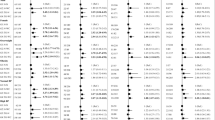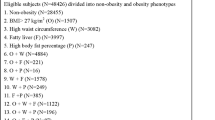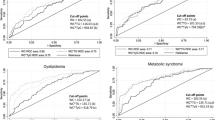Abstract
OBJECTIVE: To examine different clusterings of the insulin resistance-associated cardiovascular risk factors with respect to different types of obesity.
DESIGN: A screening programme for obesity (body mass index; BMI≥30 kg/m2) and abdominal adiposity (waist-to-hip ratio; WHR≥1.00 in men and ≥0.88 in women).
SETTINGS: Pieksämäki District Health Centre and the Community Health Centre of the City of Tampere, Finland.
SUBJECTS: All volunteers were either aged 36, 41, 46 or 51 y (n=1148) and living in the town of Pieksämäki, with a control population of 162 subjects in the City of Tampere.
MAIN OUTCOME MEASURES: Different clusterings of: 1) hypertension (a systolic blood pressure≥160 mmHg and/or a diastolic blood pressure ≥95 mmHg or concurrent drug treatment for hypertension); 2) hyper-triglyceridaemia≥1.70 mmol/l; 3) a low level of high-density-lipoprotein (HDL) cholesterol; <1.00 mmol/l in men, <1.20 mmol/l in women; 4) abnormal glucose metabolism (impaired glucose tolerance or non-insulin-dependent diabetes) and 5) hyperinsulinaemia with a fasting plasma insulin≥13.0 mU/l.
RESULTS: The prevalence of a cluster consisting of dyslipidaemia (hypertriglyceridaemia and/or low HDL-cholesterol) and insulin resistance (abnormal glucose metabolism and/or hyperinsulinaemia) was found to be 4% in the control subjects, 18% in the abdominal adipose subjects (WHR≥1.00 in men and ≥0.88 in women with a BMI<30 kg/m2), 28% in the ‘pure’ obese subjects (BMI≥30 kg/m2 with WHR<1.00 in men and <0.88 in women), and 46% in the central obese subjects (subjects showing both ‘pure’ obesity and abdominal adiposity). The prevalence rates of the other clusterings of abnormalities varied similarly according to the type of obesity.
CONCLUSION: Clusterings of insulin resistance-associated abnormalities were related to the type of obesity in both middle-aged men and middle-aged women.
This is a preview of subscription content, access via your institution
Access options
Subscribe to this journal
Receive 12 print issues and online access
$259.00 per year
only $21.58 per issue
Buy this article
- Purchase on Springer Link
- Instant access to full article PDF
Prices may be subject to local taxes which are calculated during checkout
Similar content being viewed by others
Author information
Authors and Affiliations
Rights and permissions
About this article
Cite this article
Vanhala, M., Pitkäjärvi, T., Kumpusalo, E. et al. Obesity type and clustering of insulin resistance-associated cardiovascular risk factors in middle-aged men and women. Int J Obes 22, 369–374 (1998). https://doi.org/10.1038/sj.ijo.0800597
Received:
Revised:
Accepted:
Published:
Issue Date:
DOI: https://doi.org/10.1038/sj.ijo.0800597
Keywords
This article is cited by
-
High prevalence of obesity, central obesity and abnormal glucose tolerance in the middle-aged Finnish population
BMC Public Health (2008)
-
Abdominal Obesity and Coronary Heart Disease in Thai Men
Obesity (2007)
-
Determinants of normoglycemia and contribution to cardiovascular risk factors in a Chinese population: The Hong Kong Cardiovascular Risk Factor Study
Journal of Endocrinological Investigation (2006)
-
Impact of Obesity and Body Fat Distribution on Cardiovascular Risk Factors in Hong Kong Chinese
Obesity Research (2004)
-
The metabolic syndrome
Eating and Weight Disorders - Studies on Anorexia, Bulimia and Obesity (2002)



